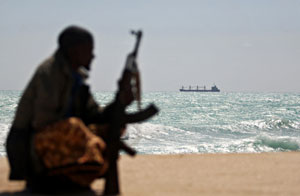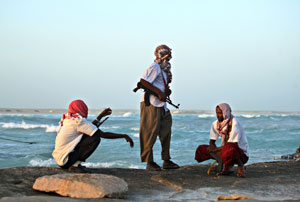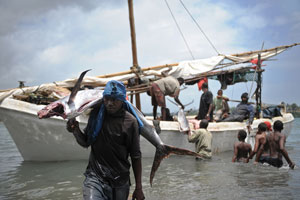The New Port of Piracy
By Pervaiz Asghar | News & Politics | Published 15 years ago
In the early morning of June 2, the MV QSM Dubai, a Panama-flagged and Dubai-owned vessel, was hijacked by Somali pirates. The ship, carrying a consignment of sugar from Brazil to the Somali port of Bossaso, was rounding the pirate-infested Gulf of Aden when it was attacked. Such brazen incidents have by now become so routine that one may be forgiven for not affording them a second glance. For Pakistan at least, what distinguished the storming of this sea vessel from other engagments was the unfortunate killing of the ship’s skipper, Captain Syed Jafar Jaffri, a Pakistani and a seasoned master mariner. It also happened to be the first recorded case of a death of a ship captain in any Somalian piracy-related incident. This episode, as well as the seizure of a Pakistani-flagged fishing vessel MV Shahbaig some six months earlier, has made the nation more curious than ever about piracy off the coast of Somalia.
Piracy at sea has always evoked feelings of romanticism and mystique amongst land lubbers. It is a realm where fact and fiction mingle effortlessly. The likes of Barbarossa, Henry Morgan, Edward Teach (aka Blackbeard), Francis Drake and Jean Lafitte are as much a part of history as they are the stuff of legends. The piratic cast of Stevenson’s Treasure Island (Long John Silver, Blind Pew, Ben Gunn), as well as that of Pirates of the Caribbean, inspires glamour rather than repulsion. The bloodthirsty nature of pirates has been sidelined in the public imagination, courtesy of the kindness that history has presumably bestowed on them.
The prominent pirates of yore were technically privateers, having received a lettre de marque from one state or another whose maritime opponents they were free to plunder. More than 400 of such letters authorising captains to seek, attack and destroy enemy vessels were issued during the American War of Independence and the resulting brazen attacks on British shipping virtually crippled that country’s trade. As with Barbarossa, Robert Surcouf, Francis Drake and Jean Lafitte, one nation’s hero was another one’s villain.

Disgruntled fishermen: Experts say Somali pirates are former fishermen taking action against illegal fishing trawlers and ships that dump toxic waste into the waters around Somalia. Photo: AFP
Fast forward from the ‘golden age of piracy’ to the present. Piracy off Somalia rules the roost these days, if only for the large sums of money the pirates manage to extort as ransom. Piracy has become so synonymous with Somalia that it is difficult to tell the two apart. One would be hard-pressed to recall that it wasn’t too long ago that the Malacca strait and its adjoining archipelagos was considered the major trouble spot for this type of activity.
But what was the driving force that caused the Somalian theatre to take centre stage?
It seems it was a deep sense of injustice and resentment. Specifically, it was resentment of acts about which the developed world is in denial and the developing world blissfully unaware. The instability following the ouster of the Said Barre regime in 1991 caused a large number of foreign commercial vessels to flock to Somali waters rich in tuna, shrimp, sharks and lobsters. Since then, French, Spanish, Japanese, Kenyan, Saudi Arabian, Taiwanese and even some Pakistani trawlers, to name just a few, have reportedly been involved.
The initial acts of piracy were thus directed against large-scale illegal fishing practices and undertaken by desperate Somali fishermen incensed at the loss of their traditional fishing areas. The Somali fishermen demanded ransom as ‘compensation’ for lost revenue. Foreign fishing vessels found it convenient to resort to bribery to obtain so-called ‘fishing licenses’ from the local warlords — this became a lucrative enterprise for all involved.
What made this already-chaotic situation even worse was the widespread dumping of toxic waste off Somalia by European multinationals. Such rampant dumping of hazardous waste coupled with illegal and destructive fishing methods employed by foreign fishermen are believed to have irrevocably damaged Somalia’s coral ecosystem and marine resources. For the profiteers, all this is of scant concern: they continue to rake in fabulous amounts of money from their illegal activities.
The Islamic Courts Union (ICU) on assuming power in 2006 reasserted some sort of control over Somali waters, with both foreign incursions as well as piracy showing a declining trend. This calm was, however, short-lived as an Ethiopian invasion at the end of the year dislodged the ICU from power.

Photo: AFP
Piracy off Somalia and its countermeasures has been like a cat-and-mouse game. When the International Maritime Bureau urged shipping to stay beyond 50 nautical miles off the Somalian coast, the pirates resorted to the use of ‘motherships’ to increase their range. When the presence of foreign warships increased in the Gulf of Aden, piracy incidents off the eastern coast of Somalia fronting the Indian Ocean multiplied. When some ships started rerouting around the Cape of Good Hope and adhering to fresh warnings to stay at least 200 nautical miles off the coast, pirates resorted to the use of captured fishing vessels both to deceive the warships by mingling with the sea traffic and to conduct attacks far out at sea. The capture of the Saudi-owned super-tanker MV Sirius Star carrying $100M worth of oil, about 450 nautical miles off the coast of Kenya, took most observers by surprise.
How do they do it so effortlessly? Easy. Having chosen an area with an abundance of high value targets, all they need to do is to avoid the warships and utilise the elements of speed and surprise to overpower their prospective victims with AK47s and RPGs to intimidate and grapnels to clamber over the side. Moreover, the merchantmen being targeted are generally not armed.
Evading or taking on the pirates is not so straightforward. There are many instances of merchant vessels having shaken off their attackers, either through outrunning them or using a sonic cannon to deafen and disorientate the attackers (see the case of the Seabourne Spirit below). In one novel case, a tugboat put itself into a high-speed spin to outlast the pirates’ patience. In another first, the crew’s counter-attack managed to reclaim their ship and win the day. Also, the presence of warships do have a certain deterrent value despite the vastness of the so-called “pirate attack zones.” However, the window of opportunity for them, i.e. from the time they detect the onset of an attack to the time the operation is completed, is rather limited. There are examples, though, of pirates having been killed or captured after taking captives and at times even after obtaining ransoms. Of course, as the story of Pakistani Captain Syed Jafar Jaffri proves, many innocent people are getting caught in the middle of this ongoing territorial fight.
The main issue that maritime powers have still not come to grips with is a legal one: what to do with the so-called “persons under control.” Part of the problem stems from the 1982 definition of piracy developed by the United Nations Convention on the Law of the Sea (UNCLOS). It states that an act can only be treated as piracy if committed on the high seas. As far as territorial waters are concerned, they fall under the jurisdiction of the coastal state, which can either treat such incidents as “armed robbery” or make laws to define them as acts of piracy. Realising that there is no stable governance in Somalia, some countries, the US and the UK in particular, have signed bilateral agreements with its neighbour to the south, Kenya, enabling prosecution of captured pirates to be carried out there.
The United Nations Security Council, recognising the inadequacies of governance and the need to combat piracy in Somalia, authorised naval warships to pursue pirates into its territorial waters and even permitted operations within Somalia’s land borders. This made the job of capturing pirates much easier. However, prosecuting them remained governed by the national laws of the concerned country. A Dutch warship was forced to release pirates it captured when it discovered that the laws of its country only allowed them to take action when the victims are from the Netherlands. And although German warships are presently operating as part of an EU anti-piracy mission, their presence seems to be for the purpose of deterrence alone, as German law dictates that all crime fighting is the exclusive preserve of the police.
On the high seas, although the state whose flag a vessel is carrying has sovereignty over it, warships of other countries may avail their inherent right of approach and visit on suspicion of piracy. The right of search, however, depends on whether the visit confirms the suspicion. To get around subsequent legal claims, the consent of the state, or even of the master of the vessel in some circumstances, is advisable. The practical problem still remains: suspected pirates operating in their own skiffs can’t be held simply on the basis of suspicion. On the other hand, warships have to be a bit cautious in dealing with pirates already in control of a captured vessel or hostages, or both, for fear of endangering their safety. Pirates attacking another ship on the high seas or resisting a warship’s legal right of visit and search are fair game.

Ending piracy: An effective outcome might be found if the international community developed a programme to prevent the illegal destructive fishing and toxic dumping in Somali waters by foreign commercial vessels. Photo: AFP
UNCLOS makes the illegality of piracy and the rights of all states to seize and prosecute the pirates very clear, the only chink being that instead of laying down any penal standards it empowers individual states to make it the subject of their national laws. Thus, the fate of captured pirates is not dependent on any standard international regime but on the legislation of the seizing or territorial state. There have been some success stories, though. The US and France have convicted Somali pirates in their home courts while the US has also extradited several pirates to Kenya under the aforementioned bilateral agreement.
The likelihood of any acceptable solution is remote without the revival of some measure of state authority in Somalia and without increased regional and international cooperation. The ease with which the international community continues to spend over $30 billion annually on reactionary measures such as patrol ships, ship re-routing and higher insurance rates is bewildering. This is done without attempting to find a viable solution.
Any solution must address the root cause of the problem. An effective outcome might be found if the international community developed a programme to prevent the illegal destructive fishing and toxic dumping in Somali waters by foreign commercial vessels — and all it would need is a fraction of the $30 billion it is already spending. The aggrieved fishing communities of Somalia’s Puntland and Mudug regions would not need to fall back on piracy. Investing a little bit more on the basic needs of the inhabitants of the poverty-stricken region could bring them into the fold of the law-abiding comity of nations.
See the related sidebar Drama on the High Seas.


